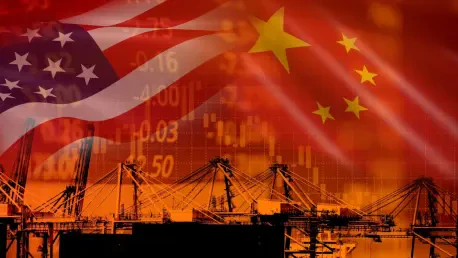The backdrop of the US-China trade discussions is a pivotal factor influencing global commodity markets, with substantial implications for energy prices. The anticipation of these talks has instilled optimism in the market, leading to an increase in oil prices as traders speculate on potential shifts in supply-demand dynamics. While the hope for reduced trade tensions is buoying market sentiment, the realization of significant tariff reductions remains crucial for fostering stronger demand outlooks. This heightened anticipation not only underscores the intricate relationship between international diplomacy and economic trends but also highlights the sensitive nature of investor confidence. Concurrently, shifts in supply levels, influenced by both geopolitical events and organizational strategies such as OPEC+, present intricate challenges for stabilizing oil markets, adding layers of complexity to the overall scenario.
OPEC+ Strategy and Market Implications
Increase in Oil Supply Amidst Trade Uncertainties
OPEC+’s approach to oil production in the latter part of the year could bring about pivotal changes with the potential to significantly sway global energy dynamics. The concerted effort to ramp up supply despite uncertain trade relations injects complexity into the marketplace, posing risks and opportunities. Although bolstered supply might contribute to an oil surplus, steadfast adherence to production quotas remains vital to circumvent destabilization. Notably, Kazakhstan’s exploration of compliance options reflects broader concerns among member nations, grappling with aligning national interests with organizational mandates. Such strategic production decisions by OPEC+ member countries underscore their attempt to balance output levels to maintain market harmony. However, the intricacies of satisfying national economic goals while supporting collective targets highlight a delicate equilibrium that must be navigated with foresight and precision.
Inventory Fluctuations and Their Economic Impact
American Petroleum Institute data serves as a critical marker, offering a snapshot of inventory trends that contribute to shaping market expectations. Recent figures indicating declines in US crude and gasoline inventories, juxtaposed with increases in distillates, portray a mixed scenario. These fluctuations reflect broader economic patterns where shifts in stockpile levels can have far-reaching implications for pricing structures and investor strategies. Understanding these movements allows for more nuanced assessments of market resilience amidst a volatile economic backdrop. Furthermore, this picture of inventory levels positions traders to gauge supply chain effectiveness and adapt strategies, considering both current stock realities and future predictions. As inventories serve as key indicators of future supply capacity, they invite comprehensive analyses to predict pricing trends and prepare for potential disruptions, contributing to an informed investment landscape.
European Natural Gas Dynamics
EU Strategies and Price Variations
The European Union’s ambitious plans to phase out Russian natural gas imports represent a significant strategic shift aimed at reducing energy reliance. Aspiring to cut dependence by a third by year-end, these efforts underscore strategic recalibrations in energy sourcing within a tumultuous geopolitical environment. Coupled with complex logistical planning and market assessments, this transition path illustrates the impact of external factors on price volatility. As the EU takes steps to diversify energy sources, natural gas prices have experienced a notable surge, accentuating the international economic interplay. This initiative serves as a case study in strategic energy shifts, showcasing the inherent challenges and adjustments needed to align energy supply mechanisms with geopolitical objectives, highlighting the multifaceted dimensions of energy market evolution in contemporary settings.
Disruptions and Short-Term Forecasts
Developments at the US Freeport LNG terminal present another layer in the evolving narrative, interjecting fresh considerations into gas pricing forecasts. With the recent disruption at this critical facility, there’s potential for short-term escalations in European natural gas prices, contingent on the outage’s duration. Such episodes reiterate the industry’s sensitivity to infrastructural stability and its downstream effects on energy economics. This highlights robust risk assessment processes that stakeholders must undertake to navigate disruptions effectively. Moreover, the strategic importance of maintaining operational continuity becomes increasingly apparent, as these incidents can greatly influence regional and international markets. As energy stakeholders integrate these factors into predictive models, contingency planning and responsive strategies are paramount in mitigating disruption-induced challenges, ensuring market foresight in the face of evolving complexities.
Agricultural Sector Adjustments
Coffee Production Estimates Shaping Futures Markets
The agricultural sector offers its own set of variables, where the Brazilian agricultural agency CONAB’s recent adjustments to coffee production forecasts illuminate shifting dynamics. Favorable weather conditions are driving modifications in output predictions, with both Arabica and Robusta coffee varieties seeing increased forecasts for 2025/26. Despite projections of higher yields, Arabica futures witnessed a rise, navigating market expectations amidst evolving realities. Such forecasts underscore the volatility of agricultural markets, highlighting how environmental factors intertwine with economic predictions, influencing pricing structures and futures trading strategies. This scenario creates intricate layers of influence wherein weather patterns, crop yields, and market demand intertwine, inviting stakeholders to exercise calculated research and decision-making in capitalizing on these developments. As predictions evolve, stakeholders are compelled to integrate market analyses with environmental assessments to anticipate future trends and drive informed investment solutions.
Broader Implications on Commodity Trading
The confluence of geopolitical shifts, such as trade negotiations, with agricultural estimations reflects the multifaceted nature of modern commodity trading. These elements underscore the ripple effect of geopolitical landscapes in shaping market conditions across diverse industries, from oil and natural gas to agriculture. The responsive adaptations seen in these sectors illustrate the broader impact that strategic international dialogues and environmental factors have on pricing mechanisms and trade dynamics. As companies respond to evolving forecasts and geopolitical configurations, they navigate through layers of complexity, adapting strategies to align with both predictable and unexpected shifts. This adaptive process emphasizes the importance of integrating predictive analytics, fostering enhanced decision-making that responds to the nuanced interconnectivity of global commodities in shaping economic landscapes, offering insightful guidance to stakeholders amidst ongoing developments.
Looking Ahead: Navigating Future Prospects
The agricultural industry presents its own complexities, demonstrated by the Brazilian agricultural agency CONAB’s adjustments to coffee production forecasts, shedding light on changing dynamics. Favorable weather conditions are altering output predictions, leading to increased forecasts for both Arabica and Robusta coffee varieties for the 2025/26 season. Although projections indicate higher yields, Arabica futures prices have risen, navigating market expectations amid shifting realities. These forecasts highlight the volatile nature of agricultural markets, emphasizing how environmental factors merge with economic forecasts, impacting pricing structures and futures trading strategies. This situation creates complex layers of influence, where weather patterns, crop yields, and market demand intersect, prompting stakeholders to engage in careful research and decision-making to leverage these opportunities. As predictions change, stakeholders must integrate market analyses with environmental evaluations to predict future trends and drive informed investment strategies.









